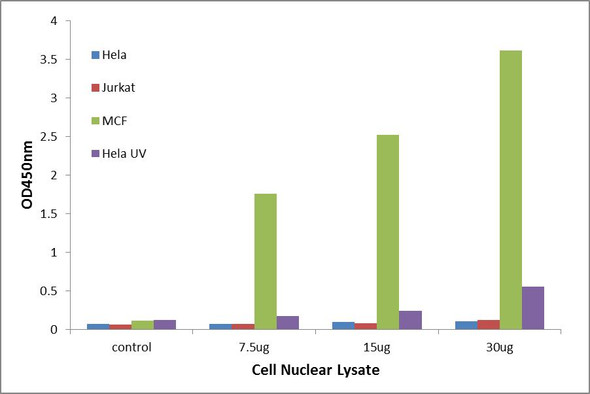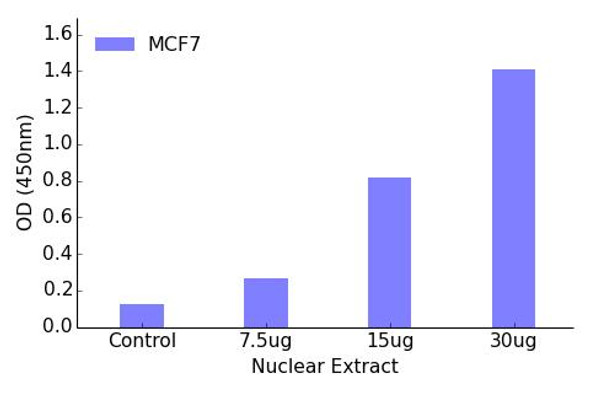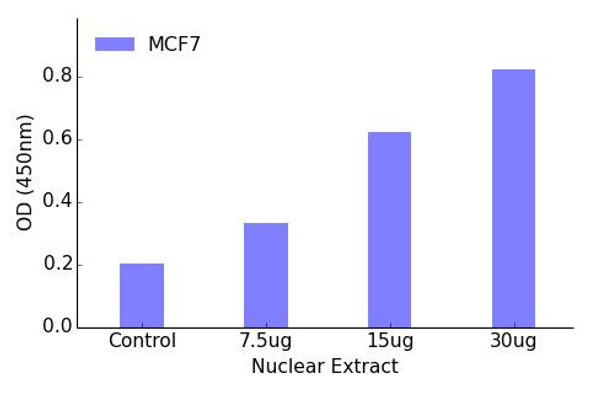Description
| Product Name: | Estrogen Receptor-beta Transcription Factor Activity Assay |
| Product Code: | TFAB00093 |
| Target: | Estrogen Receptor-beta |
| Synonyms: | Nuclear receptor subfamily 3 group A member 2 |
| Reactivity: | Human, Mouse, Rat |
| Sample Types: | Nuclear or cell lysates |
The Assay Genie Estrogen Receptor-beta transcription factor activity assay allows for the detection and qualitative analysis of endogenous levels of activated transcription factors in a variety of nuclear and cell lysates
Assay Genie ELISA kits are designed to significantly reduce experiment time and ensure sensitivity and flexibility for high-throughput screening.
| Assay Time: | 4.5 hours |
| Detection Method: | Colorimetric 450 nm |
| Size: | 12 x 8-Well Microstrips |
| Storage: | 4°C for 6 months |
| UniProt Protein Function: | ER-beta: a nuclear hormone receptor and transcription factor. Binds and activated by estrogen. Regulates gene expression and affects cellular proliferation and differentiation in target tissues. Binds estrogens with an affinity similar to that of ER-alpha, and activates expression of reporter genes containing estrogen response elements (ERE) in an estrogen-dependent manner. Eight alternatively-spliced isoforms have been described. Isoform beta-cx lacks ligand binding ability and has no or only very low ERE binding activity resulting in the loss of ligand-dependent transactivation ability. |
| UniProt Protein Details: | Protein type:DNA-binding; Nuclear receptor Chromosomal Location of Human Ortholog: 14q23.2 Cellular Component: nucleoplasm; mitochondrion; extracellular region; nucleus Molecular Function:receptor antagonist activity; protein binding; ligand-dependent nuclear receptor activity; estrogen receptor activity; enzyme binding; DNA binding; zinc ion binding; transcription coactivator activity; estrogen response element binding; steroid hormone receptor activity; transcription factor activity; steroid binding Biological Process: transcription initiation from RNA polymerase II promoter; estrogen receptor signaling pathway; induction of apoptosis by hormones; neuron migration; vagina development; negative regulation of transcription from RNA polymerase II promoter; uterus development; signal transduction; cell-cell signaling; ovarian follicle development; regulation of transcription, DNA-dependent; steroid hormone mediated signaling; gene expression; positive regulation of transcription factor activity; negative regulation of cell growth; brain development; negative regulation of epithelial cell proliferation |
| NCBI Summary: | This gene encodes a member of the family of estrogen receptors and superfamily of nuclear receptor transcription factors. The gene product contains an N-terminal DNA binding domain and C-terminal ligand binding domain and is localized to the nucleus, cytoplasm, and mitochondria. Upon binding to 17beta-estradiol or related ligands, the encoded protein forms homo- or hetero-dimers that interact with specific DNA sequences to activate transcription. Some isoforms dominantly inhibit the activity of other estrogen receptor family members. Several alternatively spliced transcript variants of this gene have been described, but the full-length nature of some of these variants has not been fully characterized. [provided by RefSeq, Jul 2008] |
| UniProt Code: | Q92731 |
| NCBI GenInfo Identifier: | 6166154 |
| NCBI Gene ID: | 2100 |
| NCBI Accession: | Q92731.2 |
| UniProt Related Accession: | Q92731 |
| Molecular Weight: | Predicted: 53 kDa |
| NCBI Full Name: | Estrogen receptor beta |
| NCBI Synonym Full Names: | estrogen receptor 2 (ER beta) |
| NCBI Official Symbol: | ESR2 |
| NCBI Official Synonym Symbols: | Erb; ESRB; ESTRB; NR3A2; ER-BETA; ESR-BETA |
| NCBI Protein Information: | estrogen receptor beta; estrogen receptor beta 4; nuclear receptor subfamily 3 group A member 2 |
| UniProt Protein Name: | 5p152 |
| UniProt Synonym Protein Names: | 5p152 |
| Protein Family: | Estrogen receptor |
| UniProt Gene Name: | ESR2 |
| UniProt Entry Name: | Q7LCB3_HUMAN |






